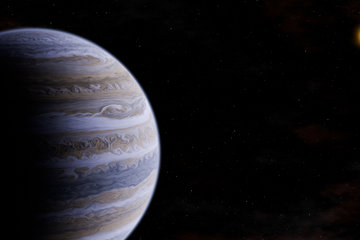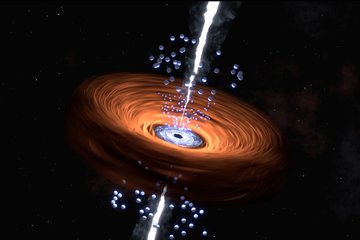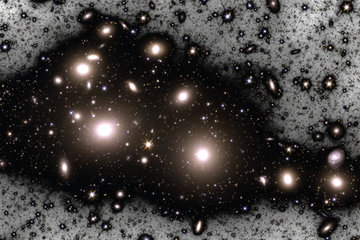A new access to the universe
Precise as a clock: pulsars in the Milky Way form large-scale observatory for gravitational waves
Astronomical observatories are usually based on Earth and study the extreme processes in the universe by capturing light as an information carrier. But not all processes in the universe produce light. For example, when galaxies merge and black holes orbit each other, they cause ripples in space-time. To make such gravitational waves measurable, astronomers have used a trick. They observed the light of pulsars, a special class of stars. Together, these stars form an observatory that is almost as large as our Milky Way.

A European team involving the Max Planck Institutes for Gravitational Physics and Radio Astronomy, together with Indian and Japanese astronomers, has discovered the first evidence of a gravitational wave background originating from the formation and evolution of the universe and its galaxies. The team used the European Pulsar Timing Array and the Indian Pulsar Timing Array, which comprise six of the most sensitive radio telescopes in the world. With these instruments, the researchers observed a previously unexplored window in the gravitational wave spectrum at wavelengths comparable to the distances between stars in the Milky Way over a period of 25 years. The target of the observations was not the gravitational waves directly, but 25 pulsar stars distributed in the Milky Way, which form the largest gravitational-wave detector to date. The data give hope for new insights into the formation and development of our universe and its galaxies
A trembling of space-time
Gravitational waves propagate at the speed of light and cause a periodic stretching and squeezing of the narrow web of space and time. The most likely origin of the background of gravitational waves at wavelengths of a few light years is the cosmic distribution of binary black-hole systems with millions to billions of solar masses. These were formed when galaxies frequently collided and merged in the early universe. In that process, supermassive black holes from the centres of these galaxies approached each other to form close binaries.
Gravitational wave detectors on Earth have been developed to measure the effects of shorter waves that occur when two stellar-mass black holes orbit close together and eventually merge. Long gravitational waves from the active early universe cannot be measured directly from Earth, but they do change the clock frequency of pulsar stars.
Cosmic lighthouses
Pulsars are stellar remnants that, like cosmic lighthouses, emit radio light in two opposite directions while rotating around an axis. If the cone of radio beams passes over the Earth, the pulsar can be measured by its periodic radio pulses. "Pulsars are excellent natural clocks. We use the incredible regularity of their signals to search for minute changes in their ticking to detect the subtle stretching and squeezing of space-time by gravitational waves originating from the distant Universe", says David Champion of the Max Planck Institute for Radio Astronomy. Here, results are based on the subset of 25 pulsars chosen to give the greatest sensitivity to a gravitational-wave background.
The results are based on decades of coordinated observing campaigns with the six of the largest radio telescopes in Europe and India. These are the 100-m radio telescope in Effelsberg (Germany), the Westerbork Synthesis Radio Telescope (Netherlands), the Lovell Telescope at Jodrell Bank Observatory (United Kingdom), the Sardinia Radio Telescope (Italy), the Nançay Radio Telescope (France) and the Giant Metrewave Radio Telescope in India.

“Analysing the data from pulsar timing arrays is complicated by the fact that Pulsar Timing Arrays use astrophysical objects as detectors“, says Jonathan Gair from the Max Planck Institute for Gravitational Physics. While you can manipulate and optimise a detector on Earth, this is not possible with the rapidly rotating stars. To detect gravitational waves as a weak signature in pulsar timing signals, researchers need to understand precisely the periodic radio light they receive from pulsars and also the inaccuracies in their clock frequency. They also make use of their long-standing knowledge of the properties of gravitational waves, which propagate in space and influence pulsars that are located inside that space. Thus, it is to be expected that changes in the timing of the observed pulsars are interlinked in a certain way. Whether this correlation becomes visible in the data is a question of statistics.
Certain or uncertain?
According to the gold-standard of physics, the measured signal, i.e. the pattern according to which the clocks of all observed pulsar clocks deviate from the norm, is only reliably proven if it is not a random signal with a probability of 99.99997 percent. A signal such as is to be expected should therefore occur purely by chance only once in a million measurements. Since this can hardly be tested in practice, the scientists simulate the standard recurrent signals of all pulsars on the computer for the specific case that no gravitational waves are present to change these signals. The measurements of the European Pulsar Timing Array - as well as those of the other international collaborations - do not yet meet that gold-standard. To reach final certainty, the teams plan to merge their data sets into a single, more comprehensive data set under the umbrella of the International Pulsar Timing Array. This would include observations from more than 100 pulsars, with 13 radio telescopes, and could be sufficient to provide irrefutable proof in the future of the existence of a gravitational wave background - a witness to an important phase in the evolution of the universe.
TB













